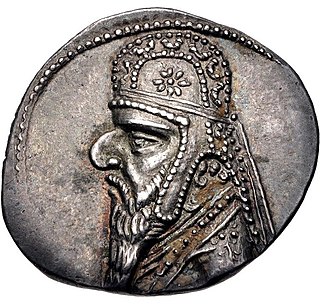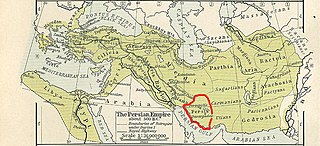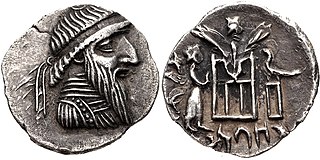
Mithridates II was king of the Parthian Empire from 124 to 91 BC. Considered one of the greatest of his dynasty to ever rule, he was known as Mithridates the Great in antiquity.

Shapur I was the second Sasanian King of Kings of Iran. The precise dating of his reign is disputed, but it is generally agreed that he ruled from 240 to 270, with his father Ardashir I as co-regent until the death of the latter in 242. During his co-regency, he helped his father with the conquest and destruction of the city of Hatra, whose fall was facilitated, according to Islamic tradition, by the actions of his future wife al-Nadirah. Shapur also consolidated and expanded the empire of Ardashir I, waged war against the Roman Empire, and seized its cities of Nisibis and Carrhae while he was advancing as far as Roman Syria. Although he was defeated at the Battle of Resaena in 243 by Roman emperor Gordian III, he was the following year able to win the Battle of Misiche and force the new Roman emperor Philip the Arab to sign a favorable peace treaty that was regarded by the Romans as "a most shameful treaty".

Mithridates I, also known as Mithridates I the Great, was king of the Parthian Empire from 165 BC to 132 BC. During his reign, Parthia was transformed from a small kingdom into a major political power in the Ancient East as a result of his conquests. He first conquered Aria, Margiana and western Bactria from the Greco-Bactrians sometime in 163–155 BC, and then waged war with the Seleucid Empire, conquering Media and Atropatene in 148/7 BC. In 141 BC, he conquered Babylonia and held an official investiture ceremony in Seleucia. The kingdoms of Elymais and Characene shortly afterwards became Parthian vassals. In c. 140 BC, while Mithridates was fighting the nomadic Saka in the east, the Seleucid king Demetrius II Nicator attempted to regain the lost territories; initially successful, he was defeated and captured in 138 BC, and shortly afterwards sent to one of Mithridates I's palaces in Hyrcania. Mithridates I then punished Elymais for aiding Demetrius, and made Persis a Parthian vassal.

Persis, also called Persia proper, is the Fars region, located to the southwest of modern-day Iran, now a province. The Persians are thought to have initially migrated either from Central Asia or, more probably, from the north through the Caucasus. They would then have migrated to the current region of Persis in the early 1st millennium BC. The country name Persia was derived directly from the Old Persian Parsa.

Phraates II was king of the Parthian Empire from 132 BC to 127 BC. He was the son and successor of Mithridates I.

Artabanus I, incorrectly known in older scholarship as Artabanus II, was king of the Parthian Empire, ruling briefly from c. 127 to 124/3 BC. His short reign ended abruptly when he died during a battle against the Yuezhi in the east. He was succeeded by his son Mithridates II.

Pabag, was an Iranian prince who ruled Istakhr, the capital of Pars, from 205 or 206 until his death sometime between 207 and 210. He was the father, stepfather, grandfather, or father-in-law of Ardashir I, the founder of the Sasanian Empire. He was succeeded by his eldest son Shapur.

Darayan II was king of Persis in the 1st century BC, a vassal state of the Parthian Empire. He was succeeded by his son Ardakhshir II.

Frataraka is an ancient Persian title, interpreted variously as “leader, governor, forerunner”. It is an epithet or title of a series of rulers in Persis from 3rd to mid 2nd century BC, or alternatively between 295 and 220 BC, at the time of the Seleucid Empire, prior to the Parthian conquest of West Asia and Iran. Studies of frataraka coins are important to historians of this period.

Shapur was an Iranian prince, who was the penultimate King of Persis from 207–210 to 211/2. He was succeeded by his younger brother Ardashir I, who founded the Sasanian Empire.

Wadfradad I, Hellenized as Autophradates I was a dynast (frataraka) of Persis in the late 2nd-century BC, ruling from 146 to 138 BC. He was succeeded by Wadfradad II.

Wahbarz, known in Greek sources as Oborzos, was a dynast (frataraka) of Persis in the 1st half of the 2nd century BC, ruling from possibly c. 205 to 164 BC. His reign was marked by his efforts to establish Persis as a kingdom independent from Seleucid authority. He was able to reign independently for three decades, and even expanded to the west, seizing the Seleucid province of Characene. In 164 BC, the Seleucids repelled Wahbarz's forces from Characene, forcing him to re-submit as a Seleucid vassal. He was succeeded by Baydad.

The Kings of Persis, also known as the Darayanids, were a series of Persian kings, who ruled the region of Persis in southwestern Iran, from the 2nd century BCE to 224 CE. They ruled as vassal kings of the Parthian Empire, until they toppled them and established the Sasanian Empire. They effectively formed some Persian dynastic continuity between the Achaemenid Empire and the Sasanian Empire.

Ardakhshir I was a dynast (frataraka) of Persis in the late 3rd-century BC, ruling sometime after 220 to c. 205 BC.
Sagdodonacus was an Iranian officer, who served as the governor of Characene from c. 184 BC to 164 BC under suzerainty of the Frataraka rulers of Persis. He was the father of Hyspaosines.

Wadfradad II, Hellenized as Autophradates II, was a dynast (frataraka) of Persis in the late 2nd-century BC, ruling sometime after 138 BC. He was appointed as frataraka by the Parthian king Mithridates I, who granted him more autonomy, most likely in an effort to maintain healthy relations with Persis as the Parthian Empire was under constant conflict with the Saka, Seleucids, and Characene. The coinage of Wadfradad II shows influence from the coins minted under Mithridates I. Wadfradad II was succeeded by Darayan I, the first of the Kings of Persis.

Darayan I was the first king of Persis, most likely invested with kingship of the region by his overlord, the Parthian monarch Phraates II sometime after 132 BC.

Wadfradad III, Hellenized as Autophradates III, was the second king of Persis, ruling sometime in the 1st half of the 1st century BC. He was the successor of Darayan I, and was succeeded by his son Darayan II.

Ardakhshir II was king of Persis in the 1st century BC, a vassal state of the Parthian Empire. An inscription written in Middle Persian on a silver cup bears his name. He was succeeded by Wahsir.

Pakor I was king of Persis in the first half of the 1st century CE, a vassal state of the Parthian Empire. He is known to have adopted on his coins the same hairstyle used on the coins of the Parthian king Phraates III.




















